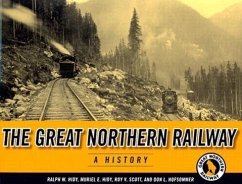- Broschiertes Buch
- Merkliste
- Auf die Merkliste
- Bewerten Bewerten
- Teilen
- Produkt teilen
- Produkterinnerung
- Produkterinnerung
In the sprawling Northwest, from the upper Mississippi River valley to Puget Sound, no railroad shaped the landscape and society like the Great Northern Railway Company. This is the complete history of that enterprise, from 1856, when the first charter was granted, through the era of James J. Hill-known as the Empire Builder-to its maturation and eventual merger in 1970, when the eight-thousand-mile Great Northern was incorporated into the massive Burlington Northern. The Great Northern Railway highlights the changes brought on by economic, political, social, and technological advances,…mehr
Andere Kunden interessierten sich auch für
![The Hiawatha Story The Hiawatha Story]() Jim ScribbinsThe Hiawatha Story25,99 €
Jim ScribbinsThe Hiawatha Story25,99 €![The Picturesque Railway: The Lithographs of John Cooke Bourne The Picturesque Railway: The Lithographs of John Cooke Bourne]() Matt ThompsonThe Picturesque Railway: The Lithographs of John Cooke Bourne25,99 €
Matt ThompsonThe Picturesque Railway: The Lithographs of John Cooke Bourne25,99 €![The 400 Story: Chicago & North Western's Premier Passenger Trains The 400 Story: Chicago & North Western's Premier Passenger Trains]() Jim ScribbinsThe 400 Story: Chicago & North Western's Premier Passenger Trains25,99 €
Jim ScribbinsThe 400 Story: Chicago & North Western's Premier Passenger Trains25,99 €![Tennessee Central Railway: History Through the Miles Tennessee Central Railway: History Through the Miles]() Barton JenningsTennessee Central Railway: History Through the Miles20,50 €
Barton JenningsTennessee Central Railway: History Through the Miles20,50 €![The Southern Railway: Further Recollections The Southern Railway: Further Recollections]() C. Pat CatesThe Southern Railway: Further Recollections19,99 €
C. Pat CatesThe Southern Railway: Further Recollections19,99 €![The Mount Washington Cog Railway: Climbing the White Mountains of New Hampshire The Mount Washington Cog Railway: Climbing the White Mountains of New Hampshire]() Bruce D. HealdThe Mount Washington Cog Railway: Climbing the White Mountains of New Hampshire19,99 €
Bruce D. HealdThe Mount Washington Cog Railway: Climbing the White Mountains of New Hampshire19,99 €![The South Eastern Railway: Its Passenger Services, Rolling Stock, Locomotives, Gradients and Express Speeds The South Eastern Railway: Its Passenger Services, Rolling Stock, Locomotives, Gradients and Express Speeds]() J. Pearson PattinsonThe South Eastern Railway: Its Passenger Services, Rolling Stock, Locomotives, Gradients and Express Speeds17,99 €
J. Pearson PattinsonThe South Eastern Railway: Its Passenger Services, Rolling Stock, Locomotives, Gradients and Express Speeds17,99 €-
-
-
In the sprawling Northwest, from the upper Mississippi River valley to Puget Sound, no railroad shaped the landscape and society like the Great Northern Railway Company. This is the complete history of that enterprise, from 1856, when the first charter was granted, through the era of James J. Hill-known as the Empire Builder-to its maturation and eventual merger in 1970, when the eight-thousand-mile Great Northern was incorporated into the massive Burlington Northern. The Great Northern Railway highlights the changes brought on by economic, political, social, and technological advances, including world wars, increased competition from other modes of transportation, and tighter government restrictions. The first part of the book (1856-1916) examines the railway's early strategies and philosophy, relations with employees, and vigorous campaigns to develop the service area. The second part of the history (1916-1970) offers an assessment of a dramatic period of transition for the railroad-international conflicts, the Great Depression, the rise of motor vehicles, increasing labor costs, and stronger unions. Illustrated with more than two hundred maps, period photographs, and drawings, the volume also includes appendixes listing the original track-laying history, track removals, ruling grades on main freight routes, and main line ruling grades from Minneapolis to Seattle. Ralph W. Hidy and Muriel E. Hidy were professors of business history at Harvard Business School. Roy V. Scott is professor of history at Mississippi State University. Don L. Hofsommer is professor of history at St. Cloud State University.
Produktdetails
- Produktdetails
- Fesler-Lampert Minnesota Herit
- Verlag: University of Minnesota Press
- Univ of Minneso
- Seitenzahl: 360
- Erscheinungstermin: März 2004
- Englisch
- Abmessung: 209mm x 274mm x 23mm
- Gewicht: 1170g
- ISBN-13: 9780816644292
- ISBN-10: 0816644292
- Artikelnr.: 12629455
- Fesler-Lampert Minnesota Herit
- Verlag: University of Minnesota Press
- Univ of Minneso
- Seitenzahl: 360
- Erscheinungstermin: März 2004
- Englisch
- Abmessung: 209mm x 274mm x 23mm
- Gewicht: 1170g
- ISBN-13: 9780816644292
- ISBN-10: 0816644292
- Artikelnr.: 12629455
Ralph W. Hidy and Muriel E. Hidy were professors of business history at Harvard Business School. Roy V. Scott is professor of history at Mississippi State University. Don L. Hofsommer is professor of history at St. Cloud State University.
Contents
Preface by Alfred D. Chandler, Jr.
Acknowledgments
Introduction
List of Abbreviations
PART I 1856 TO 1916
1 The First Ten Miles
2 Frustrated by Finance
The Branch Line Comes First
Main Line West
Growing Pains
Settlers for the Land Freight Traffic
4 Northern Pacific Interlude
Completing the Main Line
The St. Vincent Extension
5 Legislation and Litigation
Conflict in Hard Times
Laws and Lawsuits
6 The Associates Gain Control
Negotiating a Bond Purchase
Completing Rail Links
Eliminating Potential Competition
Tag Ends of a Long-Tailed Kite
7 The Manitoba
Men and Organization
Construction and Relations with Other Railroads
Terminals in the Twin Cities
Financial Management
8 Consolidations and Adjustments
The Canadian Pacific Strengthening Credit
Boston Investors
9 From Butte to Buffalo
Systematizing Administration
The Long March to Montana
Eastward to Buffalo
10 Tensions in Finance
A New Problem
Dissension, 1887-1889
11 On to Puget Sound
New Dress
Engineering Challenges
"Head of the Rake"
Sterling Bonds of 1890
Building the Transcontinental
12 Creating an Empire
Expansion in Minnesota
Control of the Northern Pacific and the Burlington
Jockeying for Position in the Northwest
Continuing Skirmishes with the Canadian Pacific
13 Developing the Northwest
Organization and Development
Improving and Strengthening Agriculture
14 Men and Mallets
Men and Organization
First Years as a Transcontinental
Fleshing Out
Traffic Generation and the Ore Lands
Motive Power, Rolling Stock, and Rates
Contents
Preface by Alfred D. Chandler, Jr.
Acknowledgments
Introduction
List of Abbreviations
PART I 1856 TO 1916
1 The First Ten Miles
2 Frustrated by Finance
The Branch Line Comes First
Main Line West
Growing Pains
Settlers for the Land Freight Traffic
4 Northern Pacific Interlude
Completing the Main Line
The St. Vincent Extension
5 Legislation and Litigation
Conflict in Hard Times
Laws and Lawsuits
6 The Associates Gain Control
Negotiating a Bond Purchase
Completing Rail Links
Eliminating Potential Competition
Tag Ends of a Long-Tailed Kite
7 The Manitoba
Men and Organization
Construction and Relations with Other Railroads
Terminals in the Twin Cities
Financial Management
8 Consolidations and Adjustments
The Canadian Pacific Strengthening Credit
Boston Investors
9 From Butte to Buffalo
Systematizing Administration
The Long March to Montana
Eastward to Buffalo
10 Tensions in Finance
A New Problem
Dissension, 1887-1889
11 On to Puget Sound
New Dress
Engineering Challenges
"Head of the Rake"
Sterling Bonds of 1890
Building the Transcontinental
12 Creating an Empire
Expansion in Minnesota
Control of the Northern Pacific and the Burlington
Jockeying for Position in the Northwest
Continuing Skirmishes with the Canadian Pacific
13 Developing the Northwest
Organization and Development
Improving and Strengthening Agriculture
14 Men and Mallets
Men and Organization
First Years as a Transcontinental
Fleshing Out
Traffic Generation and the Ore Lands
Motive Power, Rolling Stock, and Rates
15 Locals, Limiteds, and Liners
Expansion and Improvements
Of Things Nautical
Advertising, Glacier Park, and Rocky
Express, Mail, and Silk
Pricing the Service
16 Corporate Structure and Finance
Early Experience
Consolidating Properties
Finances of a Maturing Railroad
17 "Leading the Band"
Basic Principles
Union–Management Relations, 1883-1893
The ARU Strike and Its Aftermath
Toward Parity with Competitors, 1900-1916
PART II 1916 TO 1970 23 An Attempted Merger
Introduction
18 World War I and the USRA
The Heritage
The GN under Federal Control
Return to Private Operation
19 Of Good News and Bad
Preparing for Control
Frustrations and Realities
Fighting Recession
Resuming Course—with a Difference
20 Polishing the Operation
Upgrading Plant and Equipment
Reducing Costs
Conquering the Cascades
Building Freight Traffic
21 Passenger Business and Change
The St. Paul Union Depot
Highway Competition
Upgrading Transcontinental Travel
Advertising and Promotion
24 Corporate Health
Growth in Funded Debt Performance
25 The Tangled Ways ofFinance
Setting the Course
Financial Management
Over the Hurdle
Controlling Expense
22 Expansion and Development More Branch Lines
Lure of California
Frustrations in Colonizing
Agricultural Diversification and Irrigation
Northern Montana: Special Problems
26 Traffic and Profits in Adversity
The Passenger Department
Truck Competition
Developmental Programs and Federal Stimulants
Survival
27 The Pressures of War— Again
Gavin's Preparations
Mobilization
Cooperation under Regulation
Performance and Financial Policy
28 Labor-Management Relations in Depression and War
182 Cooperation in Hard Times
War and Prosperity
29 Prosperity Under Stress
Expectations and Realities
Maximizing Efficiency
The Operating and Financial Record
30 John Budd and a Changing Environment
The New Team
Railroads and Public Policy
Gradual Changes
31 Labor Tensions and Personnel
Policies
Maneuvers and Crisis
Work Rules and Compensation
Personnel Policies
32 Economic Development
Programs
Promoting Agribusiness
Stimulating Industrial Growth
Encouraging the Mining Industry
33 SD45s and Univac III
Motive Power and Rolling Stock
Road and Yard Facilities
Centralized Traffic Control, Communications, and Computers
34 "No Sacred Cows — or Goats"
The Passenger Dilemma
New Departures in Freight
Traffic
A New Marketing Structure
Performance: A Mixed Record
Notes
Appendix A Original Track-laying Record
Appendix B Track Removals
Appendix C Great Northern Railway: Ruling Grades on Main Freight Routes
Appendix D Northern Pacific: Main Line Ruling Grades Minneapolis — Seattle
Bibliography and Notes on Sources
Index
35 The Last Spike is Never
Driven
The Northern Lines—Again
Continuing the Campaign
Victory
Preface by Alfred D. Chandler, Jr.
Acknowledgments
Introduction
List of Abbreviations
PART I 1856 TO 1916
1 The First Ten Miles
2 Frustrated by Finance
The Branch Line Comes First
Main Line West
Growing Pains
Settlers for the Land Freight Traffic
4 Northern Pacific Interlude
Completing the Main Line
The St. Vincent Extension
5 Legislation and Litigation
Conflict in Hard Times
Laws and Lawsuits
6 The Associates Gain Control
Negotiating a Bond Purchase
Completing Rail Links
Eliminating Potential Competition
Tag Ends of a Long-Tailed Kite
7 The Manitoba
Men and Organization
Construction and Relations with Other Railroads
Terminals in the Twin Cities
Financial Management
8 Consolidations and Adjustments
The Canadian Pacific Strengthening Credit
Boston Investors
9 From Butte to Buffalo
Systematizing Administration
The Long March to Montana
Eastward to Buffalo
10 Tensions in Finance
A New Problem
Dissension, 1887-1889
11 On to Puget Sound
New Dress
Engineering Challenges
"Head of the Rake"
Sterling Bonds of 1890
Building the Transcontinental
12 Creating an Empire
Expansion in Minnesota
Control of the Northern Pacific and the Burlington
Jockeying for Position in the Northwest
Continuing Skirmishes with the Canadian Pacific
13 Developing the Northwest
Organization and Development
Improving and Strengthening Agriculture
14 Men and Mallets
Men and Organization
First Years as a Transcontinental
Fleshing Out
Traffic Generation and the Ore Lands
Motive Power, Rolling Stock, and Rates
Contents
Preface by Alfred D. Chandler, Jr.
Acknowledgments
Introduction
List of Abbreviations
PART I 1856 TO 1916
1 The First Ten Miles
2 Frustrated by Finance
The Branch Line Comes First
Main Line West
Growing Pains
Settlers for the Land Freight Traffic
4 Northern Pacific Interlude
Completing the Main Line
The St. Vincent Extension
5 Legislation and Litigation
Conflict in Hard Times
Laws and Lawsuits
6 The Associates Gain Control
Negotiating a Bond Purchase
Completing Rail Links
Eliminating Potential Competition
Tag Ends of a Long-Tailed Kite
7 The Manitoba
Men and Organization
Construction and Relations with Other Railroads
Terminals in the Twin Cities
Financial Management
8 Consolidations and Adjustments
The Canadian Pacific Strengthening Credit
Boston Investors
9 From Butte to Buffalo
Systematizing Administration
The Long March to Montana
Eastward to Buffalo
10 Tensions in Finance
A New Problem
Dissension, 1887-1889
11 On to Puget Sound
New Dress
Engineering Challenges
"Head of the Rake"
Sterling Bonds of 1890
Building the Transcontinental
12 Creating an Empire
Expansion in Minnesota
Control of the Northern Pacific and the Burlington
Jockeying for Position in the Northwest
Continuing Skirmishes with the Canadian Pacific
13 Developing the Northwest
Organization and Development
Improving and Strengthening Agriculture
14 Men and Mallets
Men and Organization
First Years as a Transcontinental
Fleshing Out
Traffic Generation and the Ore Lands
Motive Power, Rolling Stock, and Rates
15 Locals, Limiteds, and Liners
Expansion and Improvements
Of Things Nautical
Advertising, Glacier Park, and Rocky
Express, Mail, and Silk
Pricing the Service
16 Corporate Structure and Finance
Early Experience
Consolidating Properties
Finances of a Maturing Railroad
17 "Leading the Band"
Basic Principles
Union–Management Relations, 1883-1893
The ARU Strike and Its Aftermath
Toward Parity with Competitors, 1900-1916
PART II 1916 TO 1970 23 An Attempted Merger
Introduction
18 World War I and the USRA
The Heritage
The GN under Federal Control
Return to Private Operation
19 Of Good News and Bad
Preparing for Control
Frustrations and Realities
Fighting Recession
Resuming Course—with a Difference
20 Polishing the Operation
Upgrading Plant and Equipment
Reducing Costs
Conquering the Cascades
Building Freight Traffic
21 Passenger Business and Change
The St. Paul Union Depot
Highway Competition
Upgrading Transcontinental Travel
Advertising and Promotion
24 Corporate Health
Growth in Funded Debt Performance
25 The Tangled Ways ofFinance
Setting the Course
Financial Management
Over the Hurdle
Controlling Expense
22 Expansion and Development More Branch Lines
Lure of California
Frustrations in Colonizing
Agricultural Diversification and Irrigation
Northern Montana: Special Problems
26 Traffic and Profits in Adversity
The Passenger Department
Truck Competition
Developmental Programs and Federal Stimulants
Survival
27 The Pressures of War— Again
Gavin's Preparations
Mobilization
Cooperation under Regulation
Performance and Financial Policy
28 Labor-Management Relations in Depression and War
182 Cooperation in Hard Times
War and Prosperity
29 Prosperity Under Stress
Expectations and Realities
Maximizing Efficiency
The Operating and Financial Record
30 John Budd and a Changing Environment
The New Team
Railroads and Public Policy
Gradual Changes
31 Labor Tensions and Personnel
Policies
Maneuvers and Crisis
Work Rules and Compensation
Personnel Policies
32 Economic Development
Programs
Promoting Agribusiness
Stimulating Industrial Growth
Encouraging the Mining Industry
33 SD45s and Univac III
Motive Power and Rolling Stock
Road and Yard Facilities
Centralized Traffic Control, Communications, and Computers
34 "No Sacred Cows — or Goats"
The Passenger Dilemma
New Departures in Freight
Traffic
A New Marketing Structure
Performance: A Mixed Record
Notes
Appendix A Original Track-laying Record
Appendix B Track Removals
Appendix C Great Northern Railway: Ruling Grades on Main Freight Routes
Appendix D Northern Pacific: Main Line Ruling Grades Minneapolis — Seattle
Bibliography and Notes on Sources
Index
35 The Last Spike is Never
Driven
The Northern Lines—Again
Continuing the Campaign
Victory
Contents
Preface by Alfred D. Chandler, Jr.
Acknowledgments
Introduction
List of Abbreviations
PART I 1856 TO 1916
1 The First Ten Miles
2 Frustrated by Finance
The Branch Line Comes First
Main Line West
Growing Pains
Settlers for the Land Freight Traffic
4 Northern Pacific Interlude
Completing the Main Line
The St. Vincent Extension
5 Legislation and Litigation
Conflict in Hard Times
Laws and Lawsuits
6 The Associates Gain Control
Negotiating a Bond Purchase
Completing Rail Links
Eliminating Potential Competition
Tag Ends of a Long-Tailed Kite
7 The Manitoba
Men and Organization
Construction and Relations with Other Railroads
Terminals in the Twin Cities
Financial Management
8 Consolidations and Adjustments
The Canadian Pacific Strengthening Credit
Boston Investors
9 From Butte to Buffalo
Systematizing Administration
The Long March to Montana
Eastward to Buffalo
10 Tensions in Finance
A New Problem
Dissension, 1887-1889
11 On to Puget Sound
New Dress
Engineering Challenges
"Head of the Rake"
Sterling Bonds of 1890
Building the Transcontinental
12 Creating an Empire
Expansion in Minnesota
Control of the Northern Pacific and the Burlington
Jockeying for Position in the Northwest
Continuing Skirmishes with the Canadian Pacific
13 Developing the Northwest
Organization and Development
Improving and Strengthening Agriculture
14 Men and Mallets
Men and Organization
First Years as a Transcontinental
Fleshing Out
Traffic Generation and the Ore Lands
Motive Power, Rolling Stock, and Rates
Contents
Preface by Alfred D. Chandler, Jr.
Acknowledgments
Introduction
List of Abbreviations
PART I 1856 TO 1916
1 The First Ten Miles
2 Frustrated by Finance
The Branch Line Comes First
Main Line West
Growing Pains
Settlers for the Land Freight Traffic
4 Northern Pacific Interlude
Completing the Main Line
The St. Vincent Extension
5 Legislation and Litigation
Conflict in Hard Times
Laws and Lawsuits
6 The Associates Gain Control
Negotiating a Bond Purchase
Completing Rail Links
Eliminating Potential Competition
Tag Ends of a Long-Tailed Kite
7 The Manitoba
Men and Organization
Construction and Relations with Other Railroads
Terminals in the Twin Cities
Financial Management
8 Consolidations and Adjustments
The Canadian Pacific Strengthening Credit
Boston Investors
9 From Butte to Buffalo
Systematizing Administration
The Long March to Montana
Eastward to Buffalo
10 Tensions in Finance
A New Problem
Dissension, 1887-1889
11 On to Puget Sound
New Dress
Engineering Challenges
"Head of the Rake"
Sterling Bonds of 1890
Building the Transcontinental
12 Creating an Empire
Expansion in Minnesota
Control of the Northern Pacific and the Burlington
Jockeying for Position in the Northwest
Continuing Skirmishes with the Canadian Pacific
13 Developing the Northwest
Organization and Development
Improving and Strengthening Agriculture
14 Men and Mallets
Men and Organization
First Years as a Transcontinental
Fleshing Out
Traffic Generation and the Ore Lands
Motive Power, Rolling Stock, and Rates
15 Locals, Limiteds, and Liners
Expansion and Improvements
Of Things Nautical
Advertising, Glacier Park, and Rocky
Express, Mail, and Silk
Pricing the Service
16 Corporate Structure and Finance
Early Experience
Consolidating Properties
Finances of a Maturing Railroad
17 "Leading the Band"
Basic Principles
Union–Management Relations, 1883-1893
The ARU Strike and Its Aftermath
Toward Parity with Competitors, 1900-1916
PART II 1916 TO 1970 23 An Attempted Merger
Introduction
18 World War I and the USRA
The Heritage
The GN under Federal Control
Return to Private Operation
19 Of Good News and Bad
Preparing for Control
Frustrations and Realities
Fighting Recession
Resuming Course—with a Difference
20 Polishing the Operation
Upgrading Plant and Equipment
Reducing Costs
Conquering the Cascades
Building Freight Traffic
21 Passenger Business and Change
The St. Paul Union Depot
Highway Competition
Upgrading Transcontinental Travel
Advertising and Promotion
24 Corporate Health
Growth in Funded Debt Performance
25 The Tangled Ways ofFinance
Setting the Course
Financial Management
Over the Hurdle
Controlling Expense
22 Expansion and Development More Branch Lines
Lure of California
Frustrations in Colonizing
Agricultural Diversification and Irrigation
Northern Montana: Special Problems
26 Traffic and Profits in Adversity
The Passenger Department
Truck Competition
Developmental Programs and Federal Stimulants
Survival
27 The Pressures of War— Again
Gavin's Preparations
Mobilization
Cooperation under Regulation
Performance and Financial Policy
28 Labor-Management Relations in Depression and War
182 Cooperation in Hard Times
War and Prosperity
29 Prosperity Under Stress
Expectations and Realities
Maximizing Efficiency
The Operating and Financial Record
30 John Budd and a Changing Environment
The New Team
Railroads and Public Policy
Gradual Changes
31 Labor Tensions and Personnel
Policies
Maneuvers and Crisis
Work Rules and Compensation
Personnel Policies
32 Economic Development
Programs
Promoting Agribusiness
Stimulating Industrial Growth
Encouraging the Mining Industry
33 SD45s and Univac III
Motive Power and Rolling Stock
Road and Yard Facilities
Centralized Traffic Control, Communications, and Computers
34 "No Sacred Cows — or Goats"
The Passenger Dilemma
New Departures in Freight
Traffic
A New Marketing Structure
Performance: A Mixed Record
Notes
Appendix A Original Track-laying Record
Appendix B Track Removals
Appendix C Great Northern Railway: Ruling Grades on Main Freight Routes
Appendix D Northern Pacific: Main Line Ruling Grades Minneapolis — Seattle
Bibliography and Notes on Sources
Index
35 The Last Spike is Never
Driven
The Northern Lines—Again
Continuing the Campaign
Victory
Preface by Alfred D. Chandler, Jr.
Acknowledgments
Introduction
List of Abbreviations
PART I 1856 TO 1916
1 The First Ten Miles
2 Frustrated by Finance
The Branch Line Comes First
Main Line West
Growing Pains
Settlers for the Land Freight Traffic
4 Northern Pacific Interlude
Completing the Main Line
The St. Vincent Extension
5 Legislation and Litigation
Conflict in Hard Times
Laws and Lawsuits
6 The Associates Gain Control
Negotiating a Bond Purchase
Completing Rail Links
Eliminating Potential Competition
Tag Ends of a Long-Tailed Kite
7 The Manitoba
Men and Organization
Construction and Relations with Other Railroads
Terminals in the Twin Cities
Financial Management
8 Consolidations and Adjustments
The Canadian Pacific Strengthening Credit
Boston Investors
9 From Butte to Buffalo
Systematizing Administration
The Long March to Montana
Eastward to Buffalo
10 Tensions in Finance
A New Problem
Dissension, 1887-1889
11 On to Puget Sound
New Dress
Engineering Challenges
"Head of the Rake"
Sterling Bonds of 1890
Building the Transcontinental
12 Creating an Empire
Expansion in Minnesota
Control of the Northern Pacific and the Burlington
Jockeying for Position in the Northwest
Continuing Skirmishes with the Canadian Pacific
13 Developing the Northwest
Organization and Development
Improving and Strengthening Agriculture
14 Men and Mallets
Men and Organization
First Years as a Transcontinental
Fleshing Out
Traffic Generation and the Ore Lands
Motive Power, Rolling Stock, and Rates
Contents
Preface by Alfred D. Chandler, Jr.
Acknowledgments
Introduction
List of Abbreviations
PART I 1856 TO 1916
1 The First Ten Miles
2 Frustrated by Finance
The Branch Line Comes First
Main Line West
Growing Pains
Settlers for the Land Freight Traffic
4 Northern Pacific Interlude
Completing the Main Line
The St. Vincent Extension
5 Legislation and Litigation
Conflict in Hard Times
Laws and Lawsuits
6 The Associates Gain Control
Negotiating a Bond Purchase
Completing Rail Links
Eliminating Potential Competition
Tag Ends of a Long-Tailed Kite
7 The Manitoba
Men and Organization
Construction and Relations with Other Railroads
Terminals in the Twin Cities
Financial Management
8 Consolidations and Adjustments
The Canadian Pacific Strengthening Credit
Boston Investors
9 From Butte to Buffalo
Systematizing Administration
The Long March to Montana
Eastward to Buffalo
10 Tensions in Finance
A New Problem
Dissension, 1887-1889
11 On to Puget Sound
New Dress
Engineering Challenges
"Head of the Rake"
Sterling Bonds of 1890
Building the Transcontinental
12 Creating an Empire
Expansion in Minnesota
Control of the Northern Pacific and the Burlington
Jockeying for Position in the Northwest
Continuing Skirmishes with the Canadian Pacific
13 Developing the Northwest
Organization and Development
Improving and Strengthening Agriculture
14 Men and Mallets
Men and Organization
First Years as a Transcontinental
Fleshing Out
Traffic Generation and the Ore Lands
Motive Power, Rolling Stock, and Rates
15 Locals, Limiteds, and Liners
Expansion and Improvements
Of Things Nautical
Advertising, Glacier Park, and Rocky
Express, Mail, and Silk
Pricing the Service
16 Corporate Structure and Finance
Early Experience
Consolidating Properties
Finances of a Maturing Railroad
17 "Leading the Band"
Basic Principles
Union–Management Relations, 1883-1893
The ARU Strike and Its Aftermath
Toward Parity with Competitors, 1900-1916
PART II 1916 TO 1970 23 An Attempted Merger
Introduction
18 World War I and the USRA
The Heritage
The GN under Federal Control
Return to Private Operation
19 Of Good News and Bad
Preparing for Control
Frustrations and Realities
Fighting Recession
Resuming Course—with a Difference
20 Polishing the Operation
Upgrading Plant and Equipment
Reducing Costs
Conquering the Cascades
Building Freight Traffic
21 Passenger Business and Change
The St. Paul Union Depot
Highway Competition
Upgrading Transcontinental Travel
Advertising and Promotion
24 Corporate Health
Growth in Funded Debt Performance
25 The Tangled Ways ofFinance
Setting the Course
Financial Management
Over the Hurdle
Controlling Expense
22 Expansion and Development More Branch Lines
Lure of California
Frustrations in Colonizing
Agricultural Diversification and Irrigation
Northern Montana: Special Problems
26 Traffic and Profits in Adversity
The Passenger Department
Truck Competition
Developmental Programs and Federal Stimulants
Survival
27 The Pressures of War— Again
Gavin's Preparations
Mobilization
Cooperation under Regulation
Performance and Financial Policy
28 Labor-Management Relations in Depression and War
182 Cooperation in Hard Times
War and Prosperity
29 Prosperity Under Stress
Expectations and Realities
Maximizing Efficiency
The Operating and Financial Record
30 John Budd and a Changing Environment
The New Team
Railroads and Public Policy
Gradual Changes
31 Labor Tensions and Personnel
Policies
Maneuvers and Crisis
Work Rules and Compensation
Personnel Policies
32 Economic Development
Programs
Promoting Agribusiness
Stimulating Industrial Growth
Encouraging the Mining Industry
33 SD45s and Univac III
Motive Power and Rolling Stock
Road and Yard Facilities
Centralized Traffic Control, Communications, and Computers
34 "No Sacred Cows — or Goats"
The Passenger Dilemma
New Departures in Freight
Traffic
A New Marketing Structure
Performance: A Mixed Record
Notes
Appendix A Original Track-laying Record
Appendix B Track Removals
Appendix C Great Northern Railway: Ruling Grades on Main Freight Routes
Appendix D Northern Pacific: Main Line Ruling Grades Minneapolis — Seattle
Bibliography and Notes on Sources
Index
35 The Last Spike is Never
Driven
The Northern Lines—Again
Continuing the Campaign
Victory








